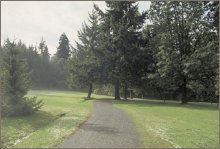Seven Essential Survival Skills Everyone Should Know
by www.SixWise.com
Being lost in the woods or stranded on an island is more likely
for some people, such as avid off-road mountain bikers or
die-hard adventure seekers. But there is a chance that anyone
-- not just actors on TV but real people too -- could find
themselves in these situations.
(Really, it's not that hard to take a wrong turn and find
yourself in the middle of nowhere, not sure which direction
is home -- just ask the Florida
jogger who recently spent four days lost in swamplands
when he took a wrong turn!)
|

Send these seven essential survival tips to everyone
you know who loves the great outdoors.
|
If you do find yourself stuck in the woods, on an island
or in any other precarious, outdoor situation, knowing the
following skills will be essential to your survival (and they're
things that everyone can do).
1. Find Clean Water
People can survive weeks without food but only a few days
without water, so securing a safe drinking water source is
one of the first things you'll need to do. If you are near
a river, lake or stream, you have a water source but will
need to purify it before drinking (unless you know
the water is clean). Due to their high salinity, salt water
sources are NOT safe to drink, even after purifying.
You can filter your water by passing it through a sock or
shirt (or this handy survival
filter made from birch bark and gravel) to remove sediment
and such, but this does not mean the water is safe to drink.
It could still contain:
-
Parasitic worms
-
Bacteria
-
Viruses
-
Chemicals
To purify the water, you'll need to boil it for at least
several minutes. NOTE: Chemicals can still exist in
water after boiling. To remove chemicals you need special
water purification tablets.
If you are having trouble finding water in the first place,
set up containers (even curved pieces of bark) to catch rainwater
and morning dew.
Condensation can be collected by digging a hole in the soil,
placing a collection container inside, then covering it with
a piece of cloth, secured with rocks. Place a pebble in the
center. Condensation will form underneath the tarp and run
toward the center, dripping into your collection container.
Water collected in this way (along with rainwater) is already
pure and doesn't require boiling before drinking.
2. Build a Fire
You will need a fire to stay warm in the evening (and during
the day, if you're in a cold region), to cook food, and to
purify water. The easiest ways to create fire when you're
in the wilderness are to use waterproof matches or a lighter
on some fine tinder. If you're stuck without either of these,
try these methods:
-
Be sure to build the fire on a rocky or sandy area so
the surrounding ground does not catch fire.
-
If you have a magnifying glass, allow the sun to pass
through it, focusing on a pile of tinder (this can be
dry grass, paper, lint, dry bark, etc.), which will smoke
and then spark. Gradually add larger pieces of bark until
the fire grows.
-
If you're in a cold area, you can use a clear piece of
flat ice, shaped by scraping onto a rock or melting it
with your hands, in place of the magnifying glass.
3. Find/Build a Shelter
Caves, rock formations and low-hanging tree limbs can all
provide shelter, but if none of these are available you'll
need to build your own. Ideally, build it in a place that
is dry, flat, stable and easy to be seen by rescuers.
The general rules for building a shelter are to keep it small,
just slightly taller than you when you sit, to keep in warmth.
You will need to secure a framework using long sticks, then
cover the framework with debris: evergreen branches, palm
fronds, leaves, grass, small sticks, anything you can find.
Also remember to put a layer of insulation over the ground
so you won't lose heat by sleeping on a cold surface. For
more details, Wilderness-Survival-Skills.com has step-by-step
instructions on how to build a debris
hut or lean-to
shelter.
4. Find Food
Eventually, you will need to find something to eat to survive
(but remember you can survive for weeks on water alone). There
will likely be plenty of plants and berries around that might
look tempting, but some may be extremely poisonous. As a result,
you can ONLY eat wild plants and berries that you KNOW are
100 percent safe to eat. Some wild plants and berries that
are safe are dandelions, orange day lilies, violets, currants
and common berries like blueberries, blackberries and strawberries.
If you are in an extreme survival situation, the U.S. Army
Survival Manual states that ants, termites, beetles, and grubs
are excellent protein sources. You can also try to catch small
animals and fish (sharpen a stick into a spear to fish in
shallow waters, or use a thorn or carved wood hook and vine
for line fishing), but be sure to cook them before eating
to kill any parasites.
|

If you find a trail, there's a good chance someone
will be by to help. If not, signal for help using fire
and smoke, a whistle or a piece of glass or other reflective
material to reflect sunlight.
|
5. Signal for Help
Assuming you don't have a cell phone, two-way radio or whistle,
you will need to figure out how to make sure a search party
can find you. First, position yourself where you think rescuers
will be looking, and where they can easily spot you (a hilltop,
clearing, beach, etc.), then stay put.
Some excellent signaling devices are smoke from a fire, a
flashlight or a magnifying glass, piece of ice, glass, shell
or other reflective material used to reflect sunlight beams.
6. Navigate So You Don't Walk in Circles
It's easy to lose your bearings in a wilderness situation
and end up walking in circles. If you know no search party
is looking for you and you must move on (if rescuers are coming,
you're better off staying put), use these tips to ensure you're
walking from point A to point B, rather than in a circle:
-
Find two landmarks ahead of you and line them up so you're
walking toward them. Then, find two landmarks behind you
and keep them lined up.
-
Make sure a constant wind is directed at the same part
of your body, and take notice if the wind direction changes.
7. Stay Calm and Motivated
Succumbing to panic is one of the worst things you can do
when stranded. You need to think clearly, size up the situation
and make rational decisions (none of which are possible while
panicking). You also need to stay motivated to survive. Think
of family and friends, and rescuers on their way to find you,
and don't give up.
For more survival skills and tips to thrive in the wilderness,
check out the source links below.
Recommended Reading
The
5 Great National Parks Almost No One Knows About
Five
of America's Most Dangerous Wild Animals -- How to Beware!
Sources
Wilderness
Survival Skills for Safe Wilderness Travel
The
Ultralight Backpacking Site
BCAdventure.com
PrimitiveWays.com